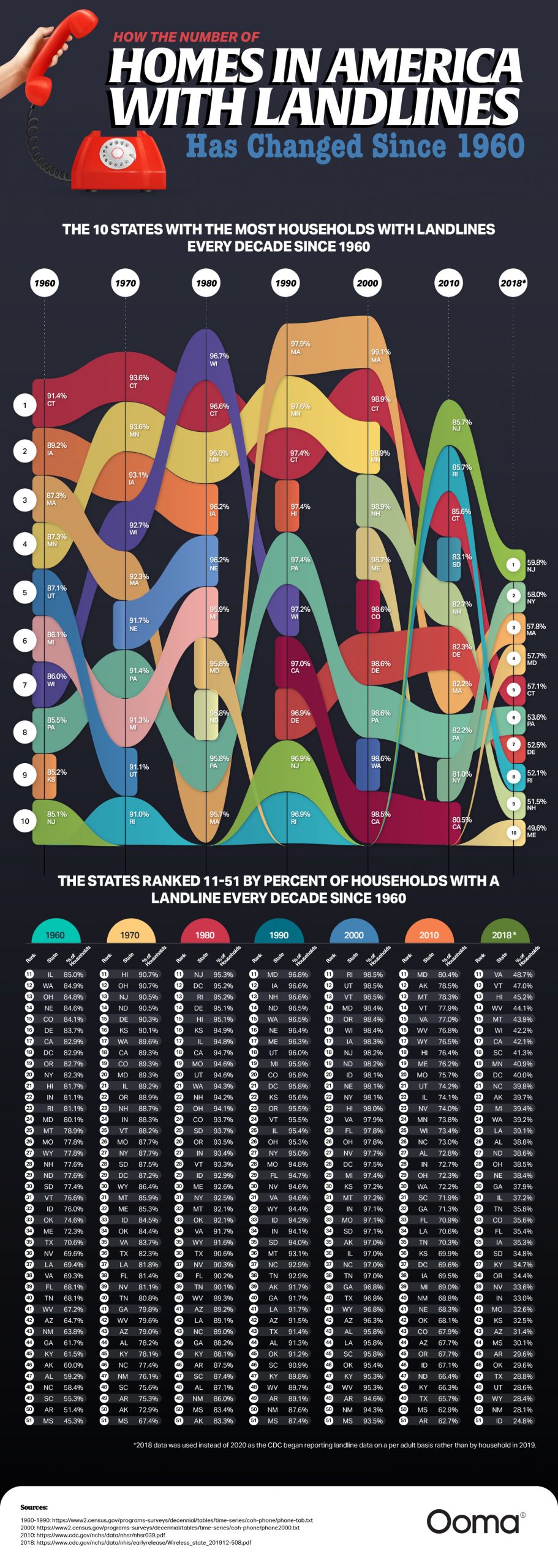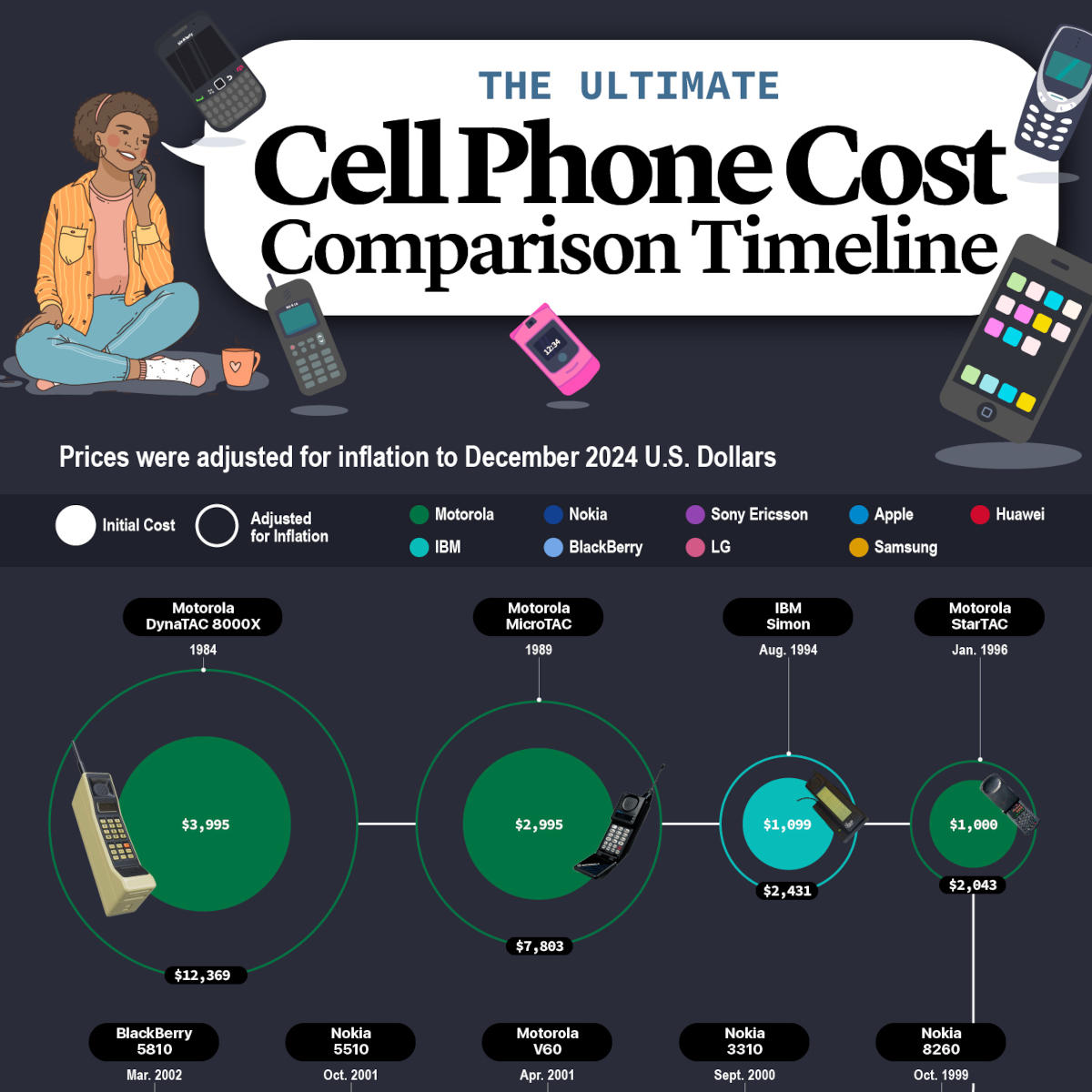How the number of homes in America with landlines has changed since 1960

In the United States, landline phones were the iconic staple of long-distance communication for many years. Landline usage in earlier decades, like the 1990s and 2000s, starkly contrasts with current times, with most adults now living in households without a landline. Many of these adults still recall a time when their families had a landline, and they likely have experience using one themselves at some point in their lives. Despite the decline, millions of households still depend on a landline for communication.
Our team at Ooma compiled census data on landline usage in U.S. households from 1960 to 2018 to examine the rise and fall of landlines nationwide.

One detail remains the same throughout the boom and decline of landlines: households in the Northeast and Midwest consistently use landlines more than anywhere else in the United States. This has remained true every decade—from the 1960s until now. The Northeast, in particular, had more infrastructure than anywhere else. Most of the population was concentrated in urban centers, such as Boston, New York City, Philadelphia and Baltimore. Therefore, telephone service was easier to implement because of dense settlement was well suited for landline adoption.
With a 91.4 percent total, Connecticut began the 1960s as the state with the highest percentage of households owning a landline and has continuously remained in the top five states ever since. At 99.1 percent in the 2000s, Massachusetts reached the highest rate of household landline ownership in the history of the United States. Overall, the 2000s marked the peak of landline ownership in the country, and it has declined in the aftermath of widespread adoption of mobile technology.
In comparison, southern states were usually the last to receive widespread landline service. It’s no surprise that states like Arkansas and Mississippi, among the last states to implement landline technology, continued to have some of the lowest percentages of households with landlines throughout all recorded decades. This delay was due to numerous reasons, such as rural populations spreading out over vast areas of land and underdeveloped infrastructure that was insufficient for such technology at the time. Even after implementation, southern states appear to be the most willing to forgo landlines in exchange for mobile-only communication.
The impact of landlines on society
The telephone landline is credited to Alexander Graham Bell, a Canadian-American inventor who patented the first telephone in the latter half of the 19th century. In an unprecedented turn of events, his invention would alter nearly every civilization in the world.
Unsurprisingly, the most significant effect the landline phone had on societies around the globe was the ability to instantaneously talk at a distance. People were no longer so heavily dependent on the postal system and telegraph to reach others far away from them. This made the landline vital for activists to build grassroots organizations and movements.
In a short time, the landline telephone became not only a method of communication, but a symbol of status. It was convenient for friends and families to stay connected and foster closer relationships with each other. Businesses could conduct transactions with clients and coordinate with suppliers more efficiently. Police, fire and other emergency services could pinpoint the exact locations of callers through the wire connection of landlines, which made the jobs of first responders much easier. Jobs and careers were built around landline services, and social norms adjusted to life with this new technology.
The death and decline of landline phones
As technology developed, wireless methods became the more convenient way to communicate by voice, effectively ending the reign of landline telephones. The convenience of not being tied to a single location, the expansion of coverage, and the increased affordability meant that cellphones rapidly replaced the space previously held by landlines.
Among current users, the main demographic that continues to use landlines more than any other cohort are adults 65 and older. Many of these older adults grew up with landlines, so they are comfortable and familiar with them. Compared to the ever-developing smartphones, landlines are a much less daunting technology to learn. Additionally, older adults are most likely to own their own homes. Younger people are more likely to rent, so households consisting of only or mostly younger people are more likely to be centered around mobile phones.
The Federal Communications Commission has worked toward eliminating the requirements for phone carriers to offer landline services. Alongside the widespread implementation of Ethernet access and fiber optics, some phone providers have chosen to drop their copper phone lines and cancel landline services entirely.
Mobile phones are not the only option for voice communication. For households and seniors, options like residential Voice over Internet Protocol (VoIP) can fill the void left by traditional household landlines with much more efficient and cost-effective technologies. And if you’re a business owner, ask us about POTS line replacement.
1960
| State | Percent of Households with a Landline | |
| 1 | Connecticut | 91.4% |
| 2 | Iowa | 89.2% |
| 3 | Massachusetts | 87.3% |
| 4 | Minnesota | 87.3% |
| 5 | Utah | 87.1% |
| 6 | Michigan | 86.1% |
| 7 | Wisconsin | 86.0% |
| 8 | Pennsylvania | 85.5% |
| 9 | Kansas | 85.2% |
| 10 | New Jersey | 85.1% |
| 11 | Illinois | 85.0% |
| 12 | Washington | 84.9% |
| 13 | Ohio | 84.8% |
| 14 | Nebraska | 84.6% |
| 15 | Colorado | 84.1% |
| 16 | Delaware | 83.7% |
| 17 | California | 82.9% |
| 18 | D.C. | 82.9% |
| 19 | Oregon | 82.7% |
| 20 | New York | 82.3% |
| 21 | Hawaii | 81.7% |
| 22 | Indiana | 81.1% |
| 23 | Rhode Island | 81.1% |
| 24 | Maryland | 80.1% |
| 25 | Montana | 78.9% |
| 26 | Missouri | 77.8% |
| 27 | Wyoming | 77.8% |
| 28 | New Hampshire | 77.6% |
| 29 | North Dakota | 77.6% |
| 30 | South Dakota | 77.4% |
| 31 | Vermont | 76.6% |
| 32 | Idaho | 76.0% |
| 33 | Oklahoma | 74.6% |
| 34 | Maine | 72.3% |
| 35 | Texas | 70.6% |
| 36 | Nevada | 69.6% |
| 37 | Louisiana | 69.4% |
| 38 | Virginia | 69.3% |
| 39 | Florida | 68.1% |
| 40 | Tennessee | 68.1% |
| 41 | West Virginia | 67.2% |
| 42 | Arizona | 64.7% |
| 43 | New Mexico | 63.8% |
| 44 | Georgia | 61.7% |
| 45 | Kentucky | 61.5% |
| 46 | Alaska | 60.0% |
| 47 | Alabama | 59.2% |
| 48 | North Carolina | 58.4% |
| 49 | South Carolina | 55.3% |
| 50 | Arkansas | 51.4% |
| 51 | Mississippi | 45.3% |
1970
| State | Percent of Households with a Landline | |
| 1 | Connecticut | 93.6% |
| 2 | Minnesota | 93.6% |
| 3 | Iowa | 93.1% |
| 4 | Wisconsin | 92.7% |
| 5 | Massachusetts | 92.3% |
| 6 | Nebraska | 91.7% |
| 7 | Pennsylvania | 91.4% |
| 8 | Michigan | 91.3% |
| 9 | Utah | 91.1% |
| 10 | Rhode Island | 91.0% |
| 11 | Hawaii | 90.7% |
| 12 | Ohio | 90.7% |
| 13 | New Jersey | 90.5% |
| 14 | North Dakota | 90.5% |
| 15 | Delaware | 90.3% |
| 16 | Kansas | 90.1% |
| 17 | Washington | 89.6% |
| 18 | California | 89.3% |
| 19 | Colorado | 89.3% |
| 20 | Maryland | 89.3% |
| 21 | Illinois | 89.2% |
| 22 | Oregon | 88.9% |
| 23 | New Hampshire | 88.7% |
| 24 | Indiana | 88.3% |
| 25 | Vermont | 88.2% |
| 26 | Missouri | 87.7% |
| 27 | New York | 87.7% |
| 28 | South Dakota | 87.5% |
| 29 | D.C. | 87.2% |
| 30 | Wyoming | 86.4% |
| 31 | Montana | 85.9% |
| 32 | Maine | 85.3% |
| 33 | Idaho | 84.5% |
| 34 | Oklahoma | 84.4% |
| 35 | Virginia | 83.7% |
| 36 | Texas | 82.3% |
| 37 | Louisiana | 81.8% |
| 38 | Florida | 81.4% |
| 39 | Nevada | 81.1% |
| 40 | Tennessee | 80.8% |
| 41 | Georgia | 79.8% |
| 42 | West Virginia | 79.6% |
| 43 | Arizona | 79.0% |
| 44 | Alabama | 78.2% |
| 45 | Kentucky | 78.1% |
| 46 | North Carolina | 77.4% |
| 47 | New Mexico | 76.1% |
| 48 | South Carolina | 75.6% |
| 49 | Arkansas | 75.3% |
| 50 | Alaska | 72.9% |
| 51 | Mississippi | 67.4% |
1980
| State | Percent of Households with a Landline | |
| 1 | Wisconsin | 96.7% |
| 2 | Connecticut | 96.6% |
| 3 | Minnesota | 96.6% |
| 4 | Iowa | 96.2% |
| 5 | Nebraska | 96.2% |
| 6 | Michigan | 95.9% |
| 7 | Maryland | 95.8% |
| 8 | North Dakota | 95.8% |
| 9 | Pennsylvania | 95.8% |
| 10 | Massachusetts | 95.7% |
| 11 | New Jersey | 95.3% |
| 12 | D.C. | 95.2% |
| 13 | Rhode Island | 95.2% |
| 14 | Delaware | 95.1% |
| 15 | Hawaii | 95.1% |
| 16 | Kansas | 94.9% |
| 17 | Illinois | 94.8% |
| 18 | California | 94.7% |
| 19 | Missouri | 94.6% |
| 20 | Utah | 94.6% |
| 21 | Washington | 94.3% |
| 22 | New Hampshire | 94.2% |
| 23 | Ohio | 94.1% |
| 24 | Colorado | 93.7% |
| 25 | South Dakota | 93.7% |
| 26 | Oregon | 93.5% |
| 27 | Indiana | 93.4% |
| 28 | Vermont | 93.3% |
| 29 | Idaho | 92.9% |
| 30 | Maine | 92.6% |
| 31 | New York | 92.5% |
| 32 | Montana | 92.1% |
| 33 | Oklahoma | 92.1% |
| 34 | Virginia | 91.7% |
| 35 | Wyoming | 91.6% |
| 36 | Texas | 90.6% |
| 37 | Nevada | 90.3% |
| 38 | Florida | 90.2% |
| 39 | Tennessee | 90.1% |
| 40 | West Virginia | 89.3% |
| 41 | Arizona | 89.2% |
| 42 | Louisiana | 89.1% |
| 43 | North Carolina | 89.0% |
| 44 | Georgia | 88.2% |
| 45 | Kentucky | 88.1% |
| 46 | Arkansas | 87.5% |
| 47 | South Carolina | 87.4% |
| 48 | Alabama | 87.1% |
| 49 | New Mexico | 86.0% |
| 50 | Mississippi | 83.4% |
| 51 | Alaska | 83.3% |
1990
| State | Percent of Households with a Landline | |
| 1 | Massachusetts | 97.9% |
| 2 | Minnesota | 97.6% |
| 3 | Connecticut | 97.4% |
| 4 | Hawaii | 97.4% |
| 5 | Pennsylvania | 97.4% |
| 6 | Wisconsin | 97.2% |
| 7 | California | 97.0% |
| 8 | Delaware | 96.9% |
| 9 | New Jersey | 96.9% |
| 10 | Rhode Island | 96.9% |
| 11 | Maryland | 96.8% |
| 12 | Iowa | 96.6% |
| 13 | New Hampshire | 96.6% |
| 14 | North Dakota | 96.5% |
| 15 | Washington | 96.5% |
| 16 | Nebraska | 96.4% |
| 17 | Maine | 96.3% |
| 18 | Utah | 96.0% |
| 19 | Michigan | 95.9% |
| 20 | Colorado | 95.8% |
| 21 | D.C. | 95.8% |
| 22 | Kansas | 95.6% |
| 23 | Oregon | 95.5% |
| 24 | Vermont | 95.5% |
| 25 | Illinois | 95.4% |
| 26 | Ohio | 95.3% |
| 27 | New York | 95.0% |
| 28 | Missouri | 94.8% |
| 29 | Florida | 94.7% |
| 30 | Nevada | 94.6% |
| 31 | Virginia | 94.6% |
| 32 | Wyoming | 94.4% |
| 33 | Idaho | 94.2% |
| 34 | Indiana | 94.1% |
| 35 | South Dakota | 94.0% |
| 36 | Montana | 93.1% |
| 37 | North Carolina | 92.9% |
| 38 | Tennessee | 92.9% |
| 39 | Alaska | 91.7% |
| 40 | Georgia | 91.7% |
| 41 | Louisiana | 91.7% |
| 42 | Arizona | 91.5% |
| 43 | Texas | 91.4% |
| 44 | Alabama | 91.3% |
| 45 | Oklahoma | 91.2% |
| 46 | South Carolina | 90.9% |
| 47 | Kentucky | 89.8% |
| 48 | West Virginia | 89.7% |
| 49 | Arkansas | 89.1% |
| 50 | New Mexico | 87.6% |
| 51 | Mississippi | 87.4% |
2000
| State | Percent of Households with a Landline | |
| 1 | Massachusetts | 99.1% |
| 2 | Connecticut | 98.9% |
| 3 | Minnesota | 98.9% |
| 4 | New Hampshire | 98.9% |
| 5 | Maine | 98.7% |
| 6 | Colorado | 98.6% |
| 7 | Delaware | 98.6% |
| 8 | Pennsylvania | 98.6% |
| 9 | Washington | 98.6% |
| 10 | California | 98.5% |
| 11 | Rhode Island | 98.5% |
| 12 | Utah | 98.5% |
| 13 | Vermont | 98.5% |
| 14 | Maryland | 98.4% |
| 15 | Oregon | 98.4% |
| 16 | Wisconsin | 98.4% |
| 17 | Iowa | 98.3% |
| 18 | New Jersey | 98.2% |
| 19 | North Dakota | 98.2% |
| 20 | Idaho | 98.1% |
| 21 | Nebraska | 98.1% |
| 22 | New York | 98.1% |
| 23 | Hawaii | 98.0% |
| 24 | Virginia | 97.9% |
| 25 | Florida | 97.8% |
| 26 | Ohio | 97.8% |
| 27 | Nevada | 97.7% |
| 28 | D.C. | 97.5% |
| 29 | Michigan | 97.4% |
| 30 | Kansas | 97.2% |
| 31 | Montana | 97.2% |
| 32 | Indiana | 97.1% |
| 33 | Missouri | 97.1% |
| 34 | South Dakota | 97.1% |
| 35 | Alaska | 97.0% |
| 36 | Illinois | 97.0% |
| 37 | North Carolina | 97.0% |
| 38 | Tennessee | 97.0% |
| 39 | Georgia | 96.8% |
| 40 | Texas | 96.8% |
| 41 | Wyoming | 96.8% |
| 42 | Arizona | 96.3% |
| 43 | Alabama | 95.8% |
| 44 | Louisiana | 95.8% |
| 45 | South Carolina | 95.8% |
| 46 | Oklahoma | 95.4% |
| 47 | Kentucky | 95.3% |
| 48 | West Virginia | 95.3% |
| 49 | Arkansas | 94.6% |
| 50 | New Mexico | 94.3% |
| 51 | Mississippi | 93.5% |
2010
| State | Percent of Households with a Landline | |
| 1 | New Jersey | 85.7% |
| 2 | Rhode Island | 85.7% |
| 3 | Connecticut | 85.6% |
| 4 | South Dakota | 83.1% |
| 5 | New Hampshire | 82.7% |
| 6 | Delaware | 82.3% |
| 7 | Massachusetts | 82.2% |
| 8 | Pennsylvania | 82.2% |
| 9 | New York | 81.0% |
| 10 | California | 80.5% |
| 11 | Maryland | 80.4% |
| 12 | Alaska | 78.5% |
| 13 | Montana | 78.3% |
| 14 | Vermont | 77.9% |
| 15 | Virginia | 77.0% |
| 16 | West Virginia | 76.8% |
| 17 | Wyoming | 76.5% |
| 18 | Hawaii | 76.4% |
| 19 | Maine | 76.2% |
| 20 | Missouri | 75.7% |
| 21 | Utah | 74.2% |
| 22 | Illinois | 74.1% |
| 23 | Nevada | 74.0% |
| 24 | Minnesota | 73.8% |
| 25 | Wisconsin | 73.4% |
| 26 | North Carolina | 73.0% |
| 27 | Alabama | 72.8% |
| 28 | Indiana | 72.7% |
| 29 | Ohio | 72.3% |
| 30 | Washington | 72.2% |
| 31 | South Carolina | 71.9% |
| 32 | Georgia | 71.3% |
| 33 | Florida | 70.9% |
| 34 | Louisiana | 70.6% |
| 35 | Tennessee | 70.3% |
| 36 | Kansas | 69.9% |
| 37 | D.C. | 69.6% |
| 38 | Iowa | 69.5% |
| 39 | Michigan | 69.0% |
| 40 | New Mexico | 68.8% |
| 41 | Nebraska | 68.3% |
| 42 | Oklahoma | 68.1% |
| 43 | Colorado | 67.9% |
| 44 | Arizona | 67.7% |
| 45 | Oregon | 67.7% |
| 46 | Idaho | 67.1% |
| 47 | North Dakota | 66.4% |
| 48 | Kentucky | 66.3% |
| 49 | Texas | 65.7% |
| 50 | Mississippi | 62.9% |
| 51 | Arkansas | 62.7% |
2018*
*2018 data was used instead of 2020 because the Centers for Disease Control and Prevention (CDC) began reporting landline data on a per-adult basis rather than by household in 2019.
| State | Percent of Households with a Landline | |
| 1 | New Jersey | 59.8% |
| 2 | New York | 58.0% |
| 3 | Massachusetts | 57.8% |
| 4 | Maryland | 57.7% |
| 5 | Connecticut | 57.1% |
| 6 | Pennsylvania | 53.6% |
| 7 | Delaware | 52.5% |
| 8 | Rhode Island | 52.1% |
| 9 | New Hampshire | 51.5% |
| 10 | Maine | 49.6% |
| 11 | Virginia | 48.7% |
| 12 | Vermont | 47.0% |
| 13 | Hawaii | 45.2% |
| 14 | West Virginia | 44.1% |
| 15 | Montana | 43.9% |
| 16 | Wisconsin | 42.2% |
| 17 | California | 42.1% |
| 18 | South Carolina | 41.3% |
| 19 | Minnesota | 40.9% |
| 20 | D.C. | 40.0% |
| 21 | North Carolina | 39.8% |
| 22 | Alaska | 39.7% |
| 23 | Michigan | 39.4% |
| 24 | Washington | 39.2% |
| 25 | Louisiana | 39.1% |
| 26 | Alabama | 38.8% |
| 27 | North Dakota | 38.6% |
| 28 | Ohio | 38.5% |
| 29 | Nebraska | 38.4% |
| 30 | Georgia | 37.9% |
| 31 | Illinois | 37.2% |
| 32 | Tennessee | 35.8% |
| 33 | Colorado | 35.6% |
| 34 | Florida | 35.4% |
| 35 | Iowa | 35.3% |
| 36 | South Dakota | 34.8% |
| 37 | Kentucky | 34.7% |
| 38 | Oregon | 34.4% |
| 39 | Nevada | 33.6% |
| 40 | Indiana | 33.0% |
| 41 | Missouri | 32.6% |
| 42 | Kansas | 32.5% |
| 43 | Arizona | 31.4% |
| 44 | Mississippi | 30.1% |
| 45 | Arkansas | 29.6% |
| 46 | Oklahoma | 29.6% |
| 47 | Texas | 28.8% |
| 48 | Utah | 28.6% |
| 49 | Wyoming | 28.4% |
| 50 | New Mexico | 28.1% |
| 51 | Idaho | 24.8% |
Sources:
- 1960-1990: https://www2.census.gov/programs-surveys/decennial/tables/time-series/coh-phone/phone-tab.txt
- 2000: https://www2.census.gov/programs-surveys/decennial/tables/time-series/coh-phone/phone2000.txt
- 2010: https://www.cdc.gov/nchs/data/nhsr/nhsr039.pdf
- 2018: https://www.cdc.gov/nchs/data/nhis/earlyrelease/Wireless_state_201912-508.pdf



